Sustainable Business Management Report: Amazon Case Study Analysis
VerifiedAdded on 2023/06/07
|7
|1591
|441
Report
AI Summary
This report provides a comprehensive analysis of Amazon's sustainable business management practices. It begins by introducing the concept of sustainability business management and its importance, emphasizing the need to manage resources effectively for all stakeholders. The report then focuses on Amazon as a case study, exploring the application of the waste hierarchy framework in delivering sustainability, including reducing, reusing, recycling, recovery, and disposal strategies. Furthermore, it identifies and discusses key sustainable challenges faced by Amazon, using the triple bottom line theory (profit, people, and planet) to evaluate the company's social, environmental, and economic impacts. The report concludes by summarizing the findings and emphasizing the importance of strategic decision-making for achieving sustainable business goals. References to relevant academic sources are also provided.
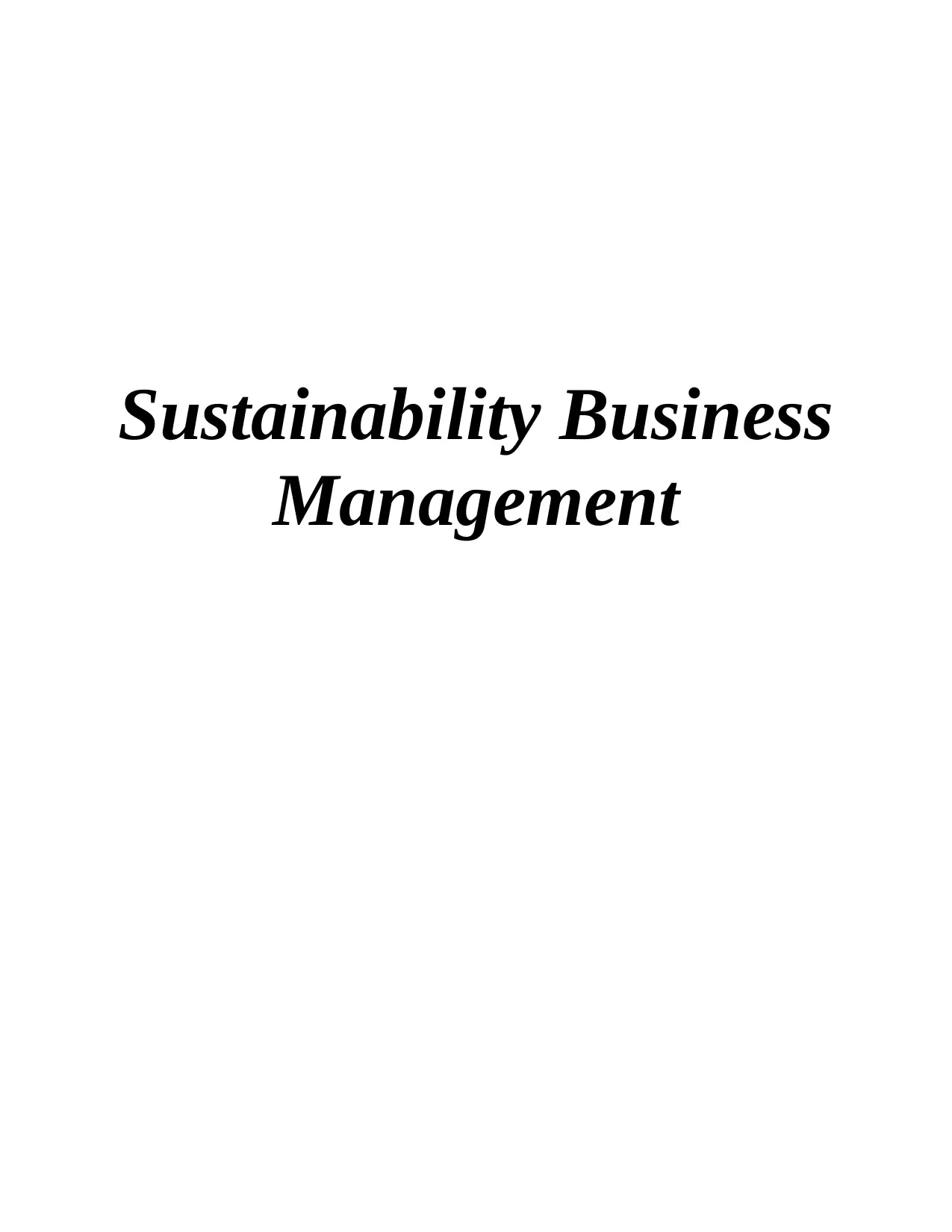
Sustainability Business
Management
Management
Paraphrase This Document
Need a fresh take? Get an instant paraphrase of this document with our AI Paraphraser
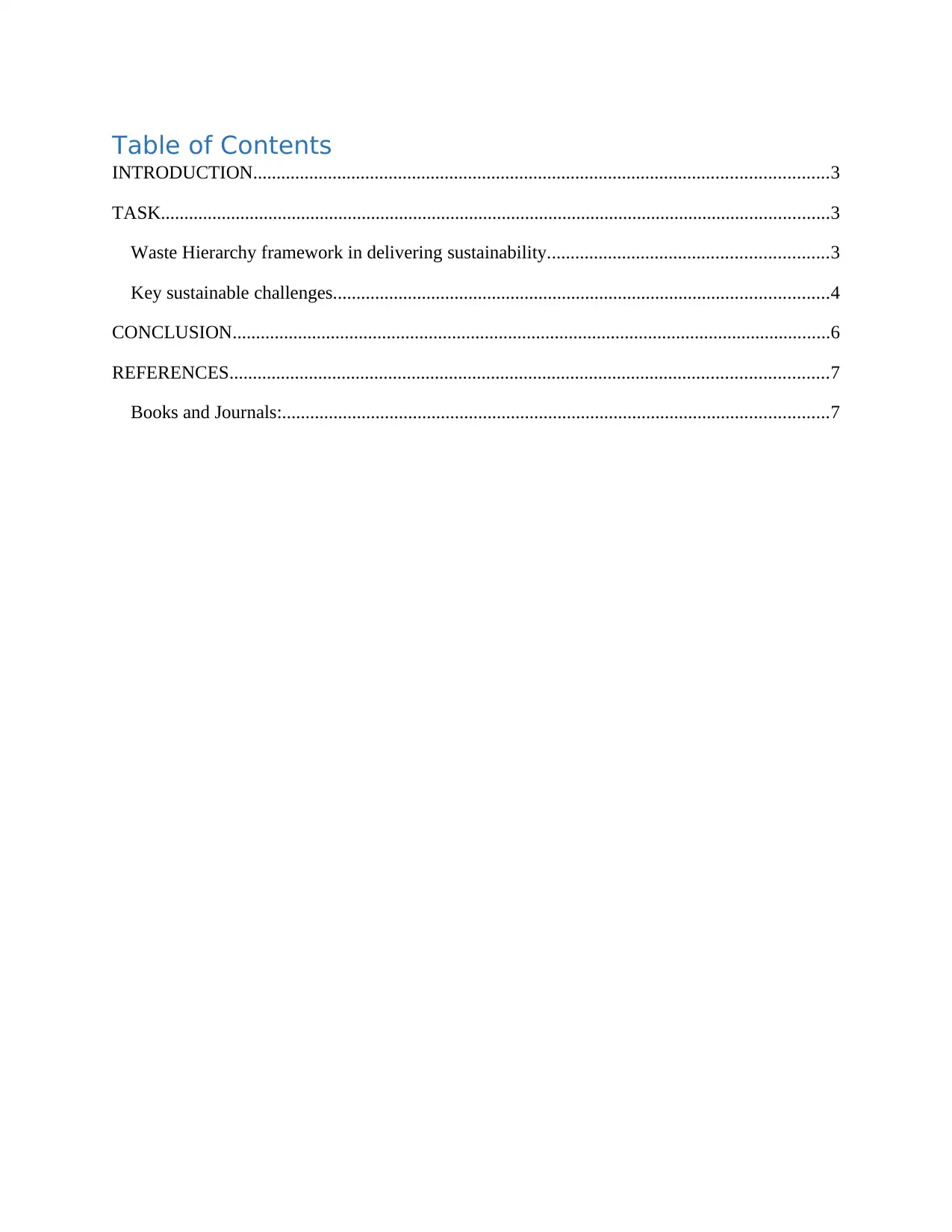
Table of Contents
INTRODUCTION...........................................................................................................................3
TASK...............................................................................................................................................3
Waste Hierarchy framework in delivering sustainability............................................................3
Key sustainable challenges..........................................................................................................4
CONCLUSION................................................................................................................................6
REFERENCES................................................................................................................................7
Books and Journals:.....................................................................................................................7
INTRODUCTION...........................................................................................................................3
TASK...............................................................................................................................................3
Waste Hierarchy framework in delivering sustainability............................................................3
Key sustainable challenges..........................................................................................................4
CONCLUSION................................................................................................................................6
REFERENCES................................................................................................................................7
Books and Journals:.....................................................................................................................7
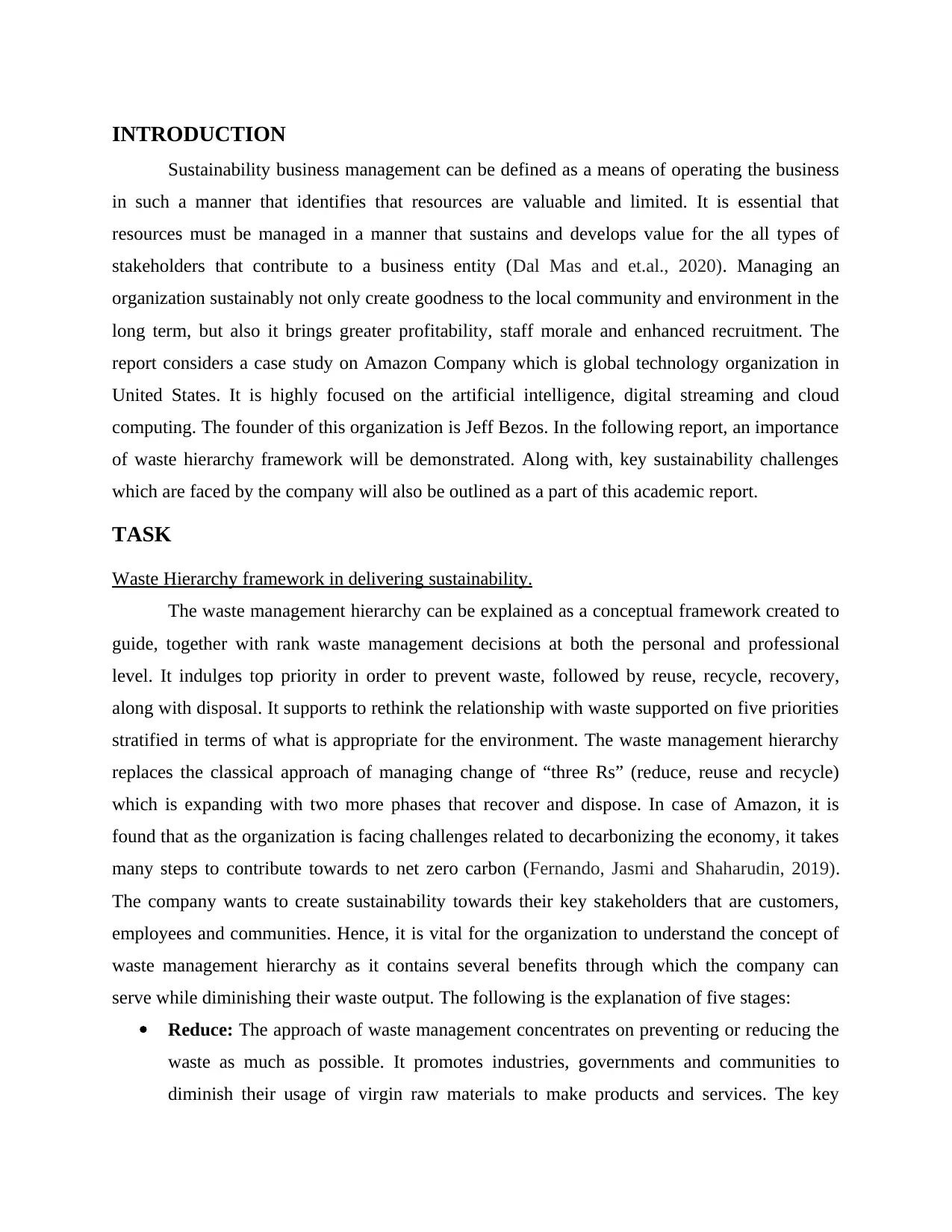
INTRODUCTION
Sustainability business management can be defined as a means of operating the business
in such a manner that identifies that resources are valuable and limited. It is essential that
resources must be managed in a manner that sustains and develops value for the all types of
stakeholders that contribute to a business entity (Dal Mas and et.al., 2020). Managing an
organization sustainably not only create goodness to the local community and environment in the
long term, but also it brings greater profitability, staff morale and enhanced recruitment. The
report considers a case study on Amazon Company which is global technology organization in
United States. It is highly focused on the artificial intelligence, digital streaming and cloud
computing. The founder of this organization is Jeff Bezos. In the following report, an importance
of waste hierarchy framework will be demonstrated. Along with, key sustainability challenges
which are faced by the company will also be outlined as a part of this academic report.
TASK
Waste Hierarchy framework in delivering sustainability.
The waste management hierarchy can be explained as a conceptual framework created to
guide, together with rank waste management decisions at both the personal and professional
level. It indulges top priority in order to prevent waste, followed by reuse, recycle, recovery,
along with disposal. It supports to rethink the relationship with waste supported on five priorities
stratified in terms of what is appropriate for the environment. The waste management hierarchy
replaces the classical approach of managing change of “three Rs” (reduce, reuse and recycle)
which is expanding with two more phases that recover and dispose. In case of Amazon, it is
found that as the organization is facing challenges related to decarbonizing the economy, it takes
many steps to contribute towards to net zero carbon (Fernando, Jasmi and Shaharudin, 2019).
The company wants to create sustainability towards their key stakeholders that are customers,
employees and communities. Hence, it is vital for the organization to understand the concept of
waste management hierarchy as it contains several benefits through which the company can
serve while diminishing their waste output. The following is the explanation of five stages:
Reduce: The approach of waste management concentrates on preventing or reducing the
waste as much as possible. It promotes industries, governments and communities to
diminish their usage of virgin raw materials to make products and services. The key
Sustainability business management can be defined as a means of operating the business
in such a manner that identifies that resources are valuable and limited. It is essential that
resources must be managed in a manner that sustains and develops value for the all types of
stakeholders that contribute to a business entity (Dal Mas and et.al., 2020). Managing an
organization sustainably not only create goodness to the local community and environment in the
long term, but also it brings greater profitability, staff morale and enhanced recruitment. The
report considers a case study on Amazon Company which is global technology organization in
United States. It is highly focused on the artificial intelligence, digital streaming and cloud
computing. The founder of this organization is Jeff Bezos. In the following report, an importance
of waste hierarchy framework will be demonstrated. Along with, key sustainability challenges
which are faced by the company will also be outlined as a part of this academic report.
TASK
Waste Hierarchy framework in delivering sustainability.
The waste management hierarchy can be explained as a conceptual framework created to
guide, together with rank waste management decisions at both the personal and professional
level. It indulges top priority in order to prevent waste, followed by reuse, recycle, recovery,
along with disposal. It supports to rethink the relationship with waste supported on five priorities
stratified in terms of what is appropriate for the environment. The waste management hierarchy
replaces the classical approach of managing change of “three Rs” (reduce, reuse and recycle)
which is expanding with two more phases that recover and dispose. In case of Amazon, it is
found that as the organization is facing challenges related to decarbonizing the economy, it takes
many steps to contribute towards to net zero carbon (Fernando, Jasmi and Shaharudin, 2019).
The company wants to create sustainability towards their key stakeholders that are customers,
employees and communities. Hence, it is vital for the organization to understand the concept of
waste management hierarchy as it contains several benefits through which the company can
serve while diminishing their waste output. The following is the explanation of five stages:
Reduce: The approach of waste management concentrates on preventing or reducing the
waste as much as possible. It promotes industries, governments and communities to
diminish their usage of virgin raw materials to make products and services. The key
⊘ This is a preview!⊘
Do you want full access?
Subscribe today to unlock all pages.

Trusted by 1+ million students worldwide
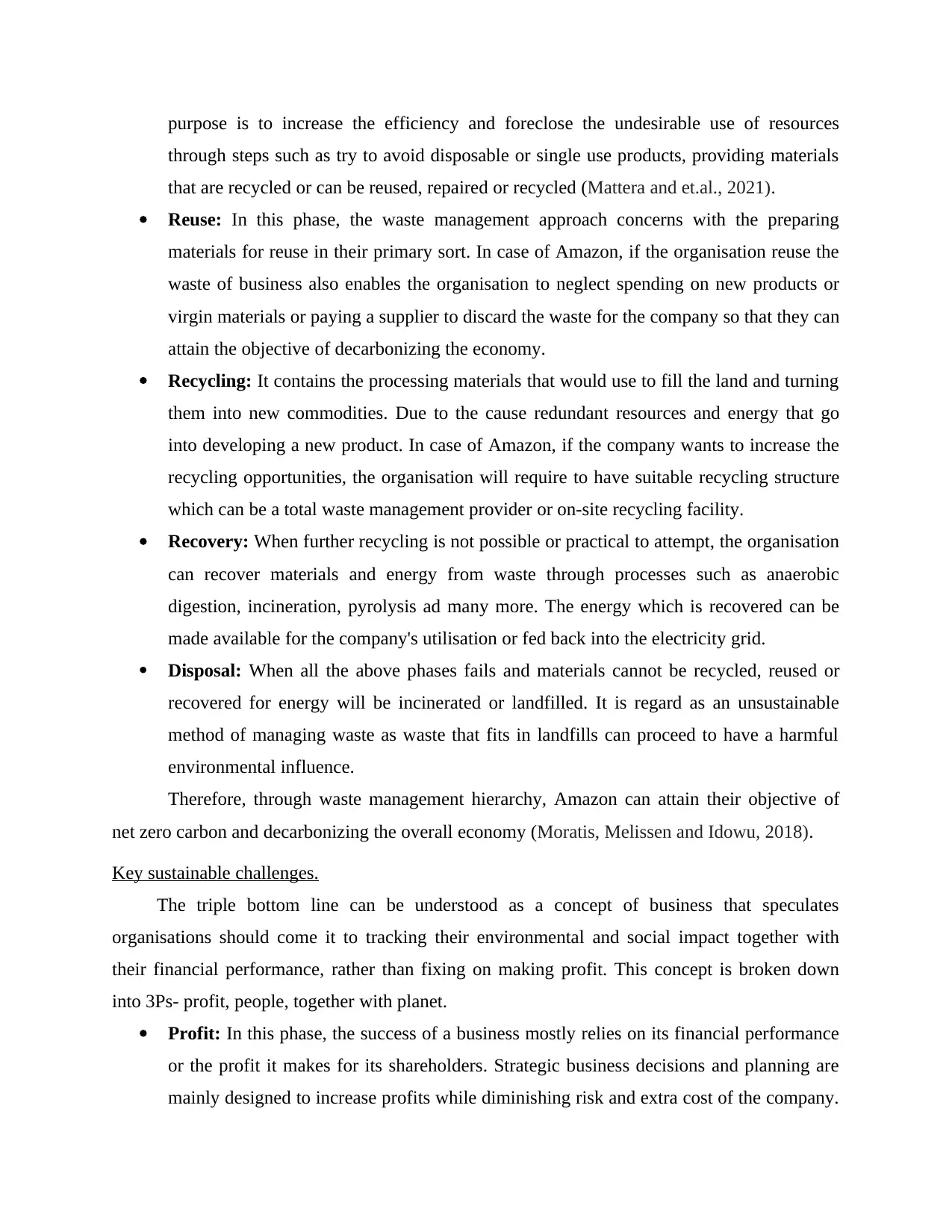
purpose is to increase the efficiency and foreclose the undesirable use of resources
through steps such as try to avoid disposable or single use products, providing materials
that are recycled or can be reused, repaired or recycled (Mattera and et.al., 2021).
Reuse: In this phase, the waste management approach concerns with the preparing
materials for reuse in their primary sort. In case of Amazon, if the organisation reuse the
waste of business also enables the organisation to neglect spending on new products or
virgin materials or paying a supplier to discard the waste for the company so that they can
attain the objective of decarbonizing the economy.
Recycling: It contains the processing materials that would use to fill the land and turning
them into new commodities. Due to the cause redundant resources and energy that go
into developing a new product. In case of Amazon, if the company wants to increase the
recycling opportunities, the organisation will require to have suitable recycling structure
which can be a total waste management provider or on-site recycling facility.
Recovery: When further recycling is not possible or practical to attempt, the organisation
can recover materials and energy from waste through processes such as anaerobic
digestion, incineration, pyrolysis ad many more. The energy which is recovered can be
made available for the company's utilisation or fed back into the electricity grid.
Disposal: When all the above phases fails and materials cannot be recycled, reused or
recovered for energy will be incinerated or landfilled. It is regard as an unsustainable
method of managing waste as waste that fits in landfills can proceed to have a harmful
environmental influence.
Therefore, through waste management hierarchy, Amazon can attain their objective of
net zero carbon and decarbonizing the overall economy (Moratis, Melissen and Idowu, 2018).
Key sustainable challenges.
The triple bottom line can be understood as a concept of business that speculates
organisations should come it to tracking their environmental and social impact together with
their financial performance, rather than fixing on making profit. This concept is broken down
into 3Ps- profit, people, together with planet.
Profit: In this phase, the success of a business mostly relies on its financial performance
or the profit it makes for its shareholders. Strategic business decisions and planning are
mainly designed to increase profits while diminishing risk and extra cost of the company.
through steps such as try to avoid disposable or single use products, providing materials
that are recycled or can be reused, repaired or recycled (Mattera and et.al., 2021).
Reuse: In this phase, the waste management approach concerns with the preparing
materials for reuse in their primary sort. In case of Amazon, if the organisation reuse the
waste of business also enables the organisation to neglect spending on new products or
virgin materials or paying a supplier to discard the waste for the company so that they can
attain the objective of decarbonizing the economy.
Recycling: It contains the processing materials that would use to fill the land and turning
them into new commodities. Due to the cause redundant resources and energy that go
into developing a new product. In case of Amazon, if the company wants to increase the
recycling opportunities, the organisation will require to have suitable recycling structure
which can be a total waste management provider or on-site recycling facility.
Recovery: When further recycling is not possible or practical to attempt, the organisation
can recover materials and energy from waste through processes such as anaerobic
digestion, incineration, pyrolysis ad many more. The energy which is recovered can be
made available for the company's utilisation or fed back into the electricity grid.
Disposal: When all the above phases fails and materials cannot be recycled, reused or
recovered for energy will be incinerated or landfilled. It is regard as an unsustainable
method of managing waste as waste that fits in landfills can proceed to have a harmful
environmental influence.
Therefore, through waste management hierarchy, Amazon can attain their objective of
net zero carbon and decarbonizing the overall economy (Moratis, Melissen and Idowu, 2018).
Key sustainable challenges.
The triple bottom line can be understood as a concept of business that speculates
organisations should come it to tracking their environmental and social impact together with
their financial performance, rather than fixing on making profit. This concept is broken down
into 3Ps- profit, people, together with planet.
Profit: In this phase, the success of a business mostly relies on its financial performance
or the profit it makes for its shareholders. Strategic business decisions and planning are
mainly designed to increase profits while diminishing risk and extra cost of the company.
Paraphrase This Document
Need a fresh take? Get an instant paraphrase of this document with our AI Paraphraser
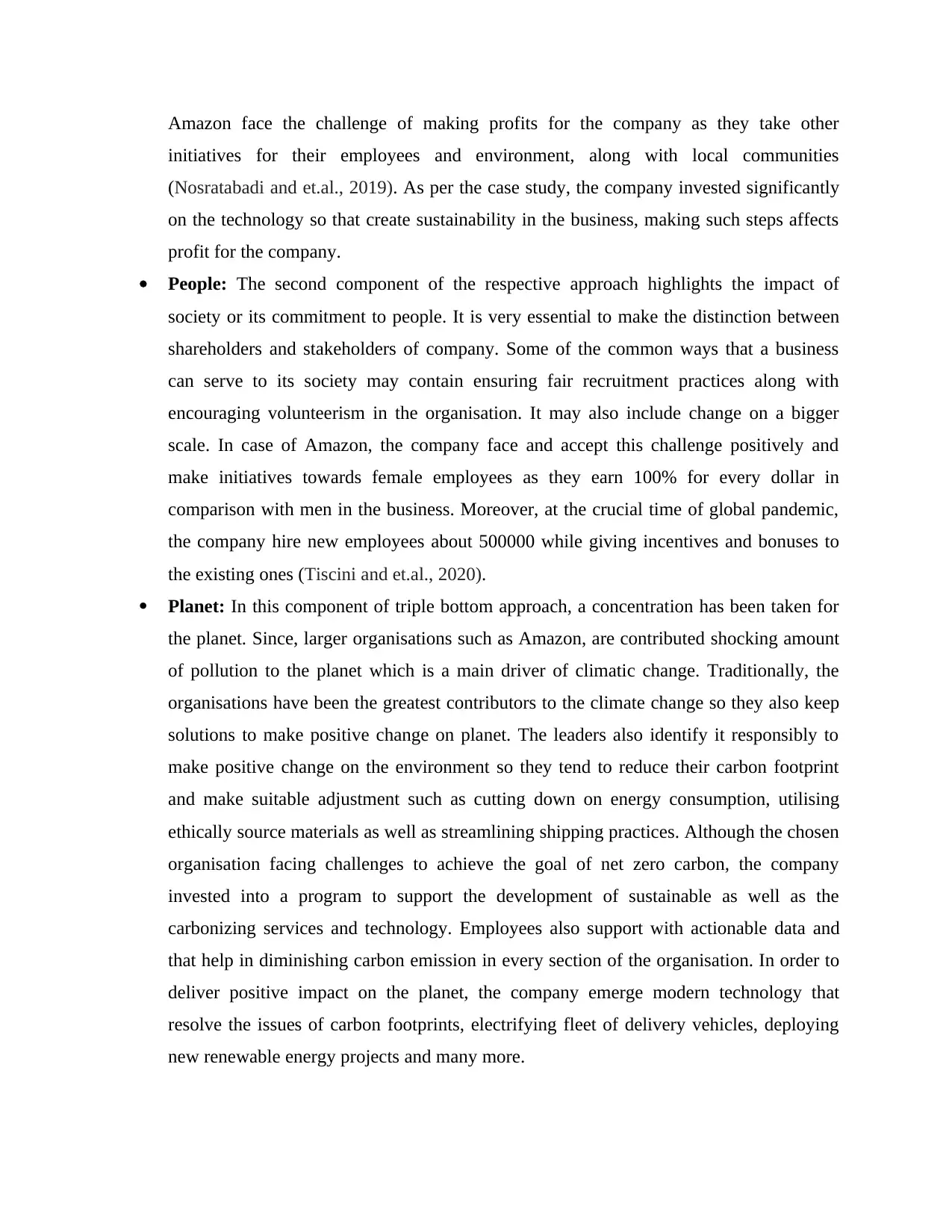
Amazon face the challenge of making profits for the company as they take other
initiatives for their employees and environment, along with local communities
(Nosratabadi and et.al., 2019). As per the case study, the company invested significantly
on the technology so that create sustainability in the business, making such steps affects
profit for the company.
People: The second component of the respective approach highlights the impact of
society or its commitment to people. It is very essential to make the distinction between
shareholders and stakeholders of company. Some of the common ways that a business
can serve to its society may contain ensuring fair recruitment practices along with
encouraging volunteerism in the organisation. It may also include change on a bigger
scale. In case of Amazon, the company face and accept this challenge positively and
make initiatives towards female employees as they earn 100% for every dollar in
comparison with men in the business. Moreover, at the crucial time of global pandemic,
the company hire new employees about 500000 while giving incentives and bonuses to
the existing ones (Tiscini and et.al., 2020).
Planet: In this component of triple bottom approach, a concentration has been taken for
the planet. Since, larger organisations such as Amazon, are contributed shocking amount
of pollution to the planet which is a main driver of climatic change. Traditionally, the
organisations have been the greatest contributors to the climate change so they also keep
solutions to make positive change on planet. The leaders also identify it responsibly to
make positive change on the environment so they tend to reduce their carbon footprint
and make suitable adjustment such as cutting down on energy consumption, utilising
ethically source materials as well as streamlining shipping practices. Although the chosen
organisation facing challenges to achieve the goal of net zero carbon, the company
invested into a program to support the development of sustainable as well as the
carbonizing services and technology. Employees also support with actionable data and
that help in diminishing carbon emission in every section of the organisation. In order to
deliver positive impact on the planet, the company emerge modern technology that
resolve the issues of carbon footprints, electrifying fleet of delivery vehicles, deploying
new renewable energy projects and many more.
initiatives for their employees and environment, along with local communities
(Nosratabadi and et.al., 2019). As per the case study, the company invested significantly
on the technology so that create sustainability in the business, making such steps affects
profit for the company.
People: The second component of the respective approach highlights the impact of
society or its commitment to people. It is very essential to make the distinction between
shareholders and stakeholders of company. Some of the common ways that a business
can serve to its society may contain ensuring fair recruitment practices along with
encouraging volunteerism in the organisation. It may also include change on a bigger
scale. In case of Amazon, the company face and accept this challenge positively and
make initiatives towards female employees as they earn 100% for every dollar in
comparison with men in the business. Moreover, at the crucial time of global pandemic,
the company hire new employees about 500000 while giving incentives and bonuses to
the existing ones (Tiscini and et.al., 2020).
Planet: In this component of triple bottom approach, a concentration has been taken for
the planet. Since, larger organisations such as Amazon, are contributed shocking amount
of pollution to the planet which is a main driver of climatic change. Traditionally, the
organisations have been the greatest contributors to the climate change so they also keep
solutions to make positive change on planet. The leaders also identify it responsibly to
make positive change on the environment so they tend to reduce their carbon footprint
and make suitable adjustment such as cutting down on energy consumption, utilising
ethically source materials as well as streamlining shipping practices. Although the chosen
organisation facing challenges to achieve the goal of net zero carbon, the company
invested into a program to support the development of sustainable as well as the
carbonizing services and technology. Employees also support with actionable data and
that help in diminishing carbon emission in every section of the organisation. In order to
deliver positive impact on the planet, the company emerge modern technology that
resolve the issues of carbon footprints, electrifying fleet of delivery vehicles, deploying
new renewable energy projects and many more.

CONCLUSION
It is concluded that an organisation should manage their business activities and function
sustainably as it not only benefits the local communities or environment in the long run but also
brings positive impact on the company. Developing sustainable business involves several
challenges and opportunities for the company. The business managers and leaders need to make
business choices and decisions strategically so that the sustainable aim can be achieved in the
business.
It is concluded that an organisation should manage their business activities and function
sustainably as it not only benefits the local communities or environment in the long run but also
brings positive impact on the company. Developing sustainable business involves several
challenges and opportunities for the company. The business managers and leaders need to make
business choices and decisions strategically so that the sustainable aim can be achieved in the
business.
⊘ This is a preview!⊘
Do you want full access?
Subscribe today to unlock all pages.

Trusted by 1+ million students worldwide
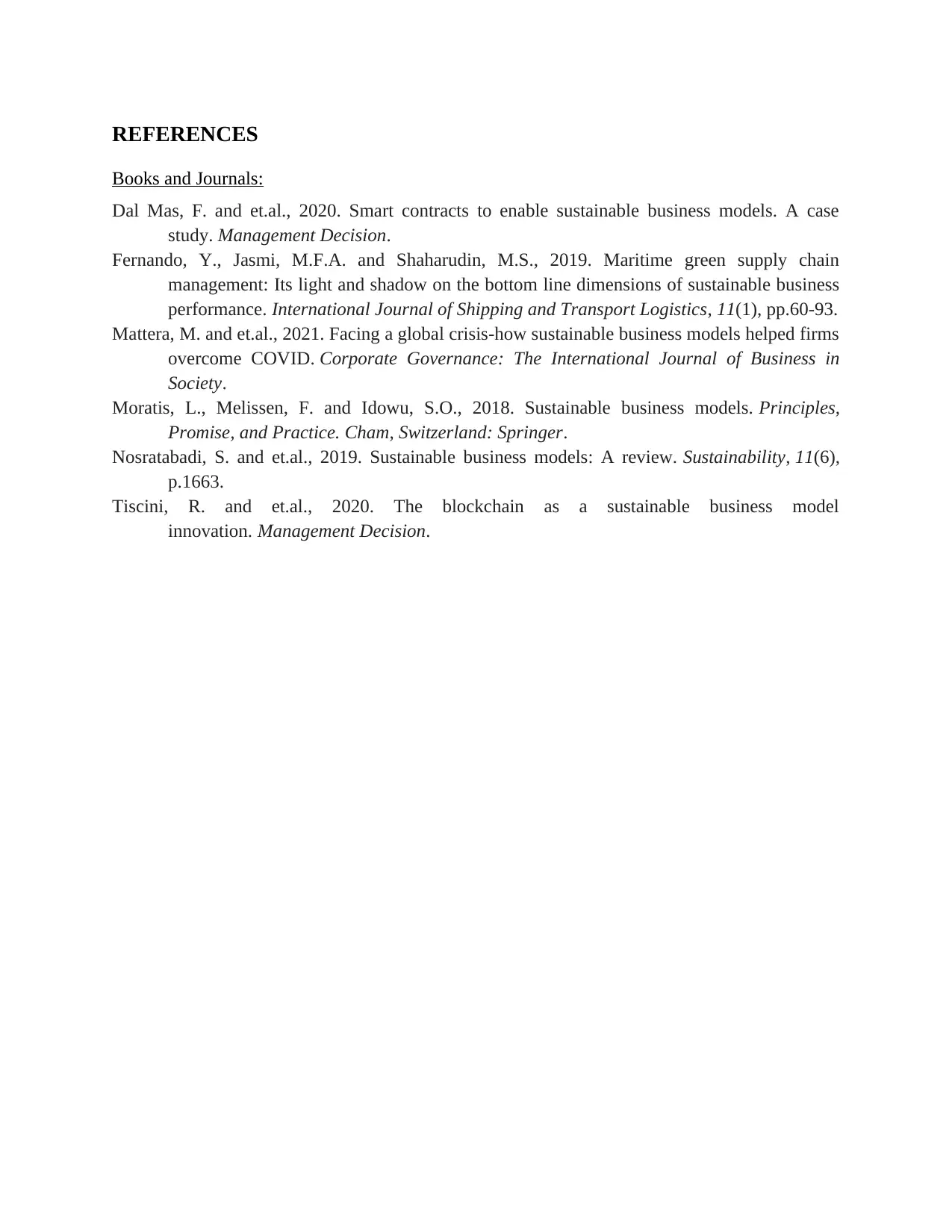
REFERENCES
Books and Journals:
Dal Mas, F. and et.al., 2020. Smart contracts to enable sustainable business models. A case
study. Management Decision.
Fernando, Y., Jasmi, M.F.A. and Shaharudin, M.S., 2019. Maritime green supply chain
management: Its light and shadow on the bottom line dimensions of sustainable business
performance. International Journal of Shipping and Transport Logistics, 11(1), pp.60-93.
Mattera, M. and et.al., 2021. Facing a global crisis-how sustainable business models helped firms
overcome COVID. Corporate Governance: The International Journal of Business in
Society.
Moratis, L., Melissen, F. and Idowu, S.O., 2018. Sustainable business models. Principles,
Promise, and Practice. Cham, Switzerland: Springer.
Nosratabadi, S. and et.al., 2019. Sustainable business models: A review. Sustainability, 11(6),
p.1663.
Tiscini, R. and et.al., 2020. The blockchain as a sustainable business model
innovation. Management Decision.
Books and Journals:
Dal Mas, F. and et.al., 2020. Smart contracts to enable sustainable business models. A case
study. Management Decision.
Fernando, Y., Jasmi, M.F.A. and Shaharudin, M.S., 2019. Maritime green supply chain
management: Its light and shadow on the bottom line dimensions of sustainable business
performance. International Journal of Shipping and Transport Logistics, 11(1), pp.60-93.
Mattera, M. and et.al., 2021. Facing a global crisis-how sustainable business models helped firms
overcome COVID. Corporate Governance: The International Journal of Business in
Society.
Moratis, L., Melissen, F. and Idowu, S.O., 2018. Sustainable business models. Principles,
Promise, and Practice. Cham, Switzerland: Springer.
Nosratabadi, S. and et.al., 2019. Sustainable business models: A review. Sustainability, 11(6),
p.1663.
Tiscini, R. and et.al., 2020. The blockchain as a sustainable business model
innovation. Management Decision.
1 out of 7
Related Documents
Your All-in-One AI-Powered Toolkit for Academic Success.
+13062052269
info@desklib.com
Available 24*7 on WhatsApp / Email
![[object Object]](/_next/static/media/star-bottom.7253800d.svg)
Unlock your academic potential
Copyright © 2020–2025 A2Z Services. All Rights Reserved. Developed and managed by ZUCOL.




